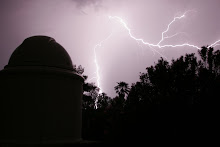Here's an image of an interesting place in our Universe. This object is a cloud of gas, and there is enough ionized Hydrogen to emit the reddish light that you see here. The light is actually a very specific emission at about 6,562.8 Angstroms, and is known as "Hydrogen-Alpha" or "H-alpha". Although the gas is glowing "hot", it would actually be quite sparse and extremely cold if you were in it. From our vantage point, which is believed to be about 400 parsecs away, (practically next door in astronomical terms!), the cloud takes on a unique shape that reminds me of a footprint from the legendary "Bigfoot" creature of North America. Thus, I call it "The Bigfoot Nebula", but it has a more scientific-sounding official catalog name of Sharpless 2-129.
The bluish coloring in his big toe is a reflection nebula - the probable reason is that the denser gas in that region has condensed and a newborn star is burning brightly enough to reflect some of its blue light against the surrounding gas.
Also visible at the upper right of this image is a smaller nebula, vdB 140, which has both reddish emission as well as bluish reflection components.
For a high-resolution version of this image, as well as image details, click here: http://www.xanaduobservatory.com/Sh2-129.htm
As seems to be normal for some time now, I've been collecting lots of imaging data and getting very little of it completed in the processing stage. The busy phase of my life seems to take over more often than I'd like. But I'm grateful for so many things, as we all should be. Today is Mother's Day, and I continue to grow in my respect for my own Mom, who taught me so much about how precious life is and how important it is to take time to appreciate the amazing beauty that surrounds us. She isn't an astronomer, but I think I owe my fascination with the Universe to her. Thanks Mom!


No comments:
Post a Comment